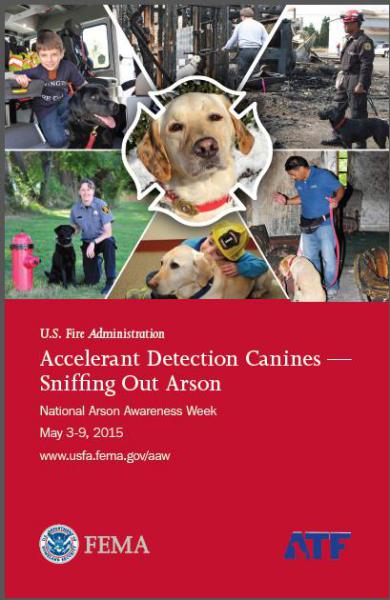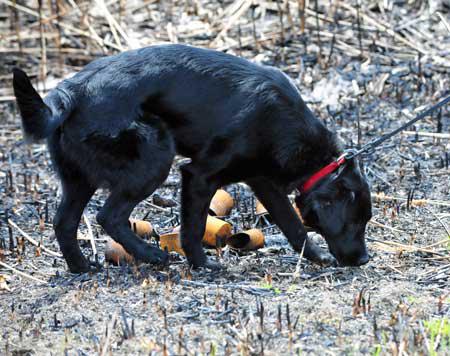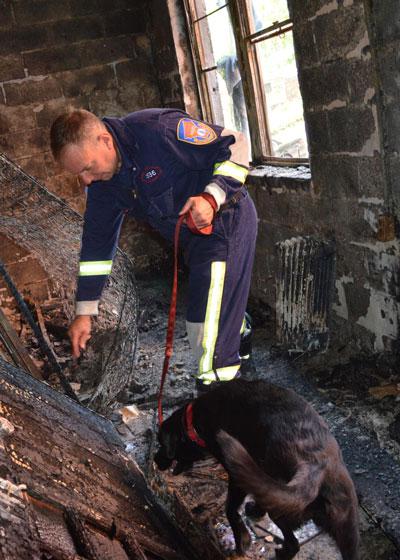| This year’s National Arson Awareness Week theme is “Accelerant Detection Canines (ADC) – Sniffing Out Arson.”
Accelerant detection canines (ADC) are motivated, accelerant detection tools. An ADC:
- Transforms from a loving pet to an arson detection tool as soon as the handler puts on the food/reward pouch.
- Has a sense of smell that is 100,000 times more acute than a human’s.
- Knows how to work a crowd. At a fire scene, the dog is encouraged to mingle with spectators and give them a good sniff. If the arsonist is in the crowd watching, the ADC will alert to the smell of the accelerant on his or her clothes, shoes or body.
- Is unbiased. The dog just sticks to the truth. If there’s an accelerant present, it alerts – simply communicating that something is there (or not there), without any personal bias, prejudice or judgment.
ADCs save time and money. An ADC:
- Is fast, covering an entire scene in less than 30 minutes. It can take humans days to do what a dog does in minutes.
- Is accurate. At best, humans can make educated guesses about possible accelerant use and will need to collect an average of 20 samples to send off to a lab for testing. With an ADC, its nose narrows down the guess work, and it winds up taking three samples on average. Higher quality lab samples speed up investigations and result in a higher conviction rate.
- Helps to rule out arson, allowing a case to close or the insurance claim process to move forward more quickly.
ADCs are valued community members. An ADC:
- Works and lives with its handler, a law enforcement officer or firefighter trained to investigate fire scenes.
- Closes more cases and acts as a deterrent resulting in a reduction of the arson problem.
- Is an excellent addition to any community’s fire prevention and education program. In addition to averaging 90 fires a year, in their off hours, ADC teams head out into their communities to teach fire safety and prevention to kids and adults.
History:
The first accelerant detection canine (ADC) was Mattie, a Labrador retriever trained by the Connecticut State Police with assistance from the Bureau of Alcohol, Tobacco, Firearms and Explosives (ATF), to respond (alert) to 17 different odors of ignitable liquids in 1986. This pilot program led the way for ATF’s Accelerant Detection Canine Program. The program trains dogs to detect a variety of ignitable liquids that could be used to start a fire.
This is all possible due to the dog’s incredible sense of smell. According to Forensic Science Central, the average human being has roughly 5 million sensitive cells within the nose. This appears to be a large number, until compared with the 200 million cells in the average dog’s nose. Further increasing the canine’s sense of smell is an organ (Jacobson’s organ) in the roof of the mouth that is not present in humans. This organ essentially allows the dog to “taste” a smell, thus strengthening its ability to detect odors. Canines detect odors directly from the source or from residual scents, odors which persist in an area after the original source is no longer present.
James Walker, former director of the Sensory Research Institute at Florida State University states that a dog’s sense of smell overpowers a human’s own by orders of magnitude — it’s up to 100,000 times as acute.
Alexandra Horowitz, author of “Inside of a Dog,” says that dogs can detect some odors in parts per trillion! She explains that a human might notice if his or her coffee has a teaspoon of sugar in it; however, a dog could detect a teaspoon of sugar in a million gallons of water, or two Olympic-size pools. |


